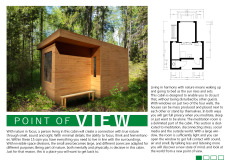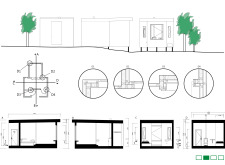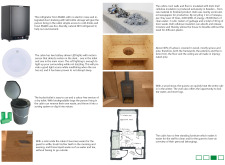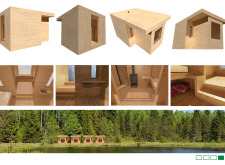5 key facts about this project
The cabin is a compact structure designed for retreat in the forests of Latvia. It provides a space for individuals seeking solitude and connection with nature. The overall design focuses on simplicity and functionality, aiming to create an environment that allows for deep relaxation and introspection. Through careful consideration of layout and materials, the cabin invites occupants to engage with their surroundings in a meaningful way.
Design Concept and Layout
Encompassing 15 square meters, the cabin features a smart layout that maximizes space without sacrificing comfort. Invisible divisions create distinct zones for different activities while promoting a sense of openness. This thoughtful organization supports mental clarity and focus, enabling occupants to immerse themselves in a peaceful atmosphere. The design encourages routines aligned with the natural day and night cycles, fostering a lifestyle in tune with nature.
Sustainability and Material Selection
Sustainability lies at the heart of the design. iCell cellulose insulation, made from uncirculated newspapers, plays a crucial role in thermal efficiency and ecological responsibility. Using this material not only helps with insulation but also minimizes waste by reusing materials. The cabin features locally sourced impregnated pine, harmonizing with the surrounding environment and promoting a sustainable approach to construction.
Functional Features and Utility
The cabin is equipped with practical features that enhance daily living. Two LED lights with motion sensors provide sufficient illumination without overwhelming the space. The wood stove serves as a heating source and is also used for boiling water. This dual-purpose feature adds to the cabin’s self-sufficient nature, allowing for essential tasks without the need for excess gadgets. A nearby sink enables simple domestic functions, underscoring the balance between practicality and simplicity.
Meditation and Connection to Nature
A dedicated meditation room is an essential component of the cabin. It is designed for quiet reflection and peace of mind. A large window connects the interior to the outside, inviting natural light and sounds into the space. This design element enhances the meditative experience, encouraging occupants to immerse themselves in the environment. The cabin serves as a refuge for personal contemplation, emphasizing the importance of connecting with nature.
The external cladding of the cabin mirrors the textures of the surrounding forest. This design choice allows it to coexist with its environment while also letting in abundant natural light. Such elements enhance the aesthetic experience and build a stronger relationship between the cabin and its natural setting.






















































